COPIA: The American Center for Wine Food and the Arts
by
Terry Sullivan
COPIA: The American Center for Wine Food & the Arts was founded by Robert Mondavi to educate adults and children about the diverse roles that food, wine and the arts have on our lives. The twelve-acre site is located along the banks of the Napa River in the Oxbow District of Napa Valley, California. It opened in November of 2001 as a non-profit organization with proceeds from ticket sales, memberships and donations supporting COPIA'S educational offerings and exhibits.
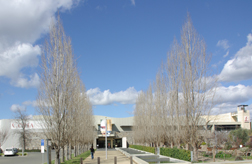 The two-floor, modern designed building is made of glass, polished concrete and metal. The glass walls flood the interior with natural light making COPIA warm and inviting. The land surrounding the building is beautifully landscaped, including a River Concert Terrace and 3 1/2 acres of organic gardens for demonstration and learning purposes. Produce and herbs from the gardens are used for the classes offered by COPIA and the onsite restaurant, Julia’s Kitchen, named for Julia Child, one of COPIA'S founding Honorary Trustees.
The two-floor, modern designed building is made of glass, polished concrete and metal. The glass walls flood the interior with natural light making COPIA warm and inviting. The land surrounding the building is beautifully landscaped, including a River Concert Terrace and 3 1/2 acres of organic gardens for demonstration and learning purposes. Produce and herbs from the gardens are used for the classes offered by COPIA and the onsite restaurant, Julia’s Kitchen, named for Julia Child, one of COPIA'S founding Honorary Trustees.
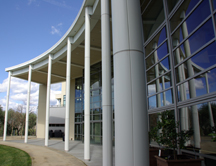 After checking in at the admissions desk and receiving a list of the classes offered for the day, we joined a tour of the building. COPIA is a large building with several areas that are used at various times for different purposes. Our guide took us outside and pointed out the area used for music concerts. She also pointed out the graceful curves of the building. We moved to the interior of the building and learned about the classroom areas used for demonstrations and classes, lasting from 30 minutes to 90 minutes. Several wine education classes are offered at COPIA, ranging from a wine tasting class to certification classes through the Wine and Spirits Education Trust (WSET). In addition to instructional classes, COPIA has several informative exhibits. Several different wine flights are offered at the Wine Spectator bar. We headed upstairs to the second floor where there is a nice view of the North and South gardens. Then we entered an interactive museum of food. Our tour ended at this spot and we could roam freely in the museum. However, time was short and we needed to meet for one of the day’s class offerings, “Wine in the Gardens.”
After checking in at the admissions desk and receiving a list of the classes offered for the day, we joined a tour of the building. COPIA is a large building with several areas that are used at various times for different purposes. Our guide took us outside and pointed out the area used for music concerts. She also pointed out the graceful curves of the building. We moved to the interior of the building and learned about the classroom areas used for demonstrations and classes, lasting from 30 minutes to 90 minutes. Several wine education classes are offered at COPIA, ranging from a wine tasting class to certification classes through the Wine and Spirits Education Trust (WSET). In addition to instructional classes, COPIA has several informative exhibits. Several different wine flights are offered at the Wine Spectator bar. We headed upstairs to the second floor where there is a nice view of the North and South gardens. Then we entered an interactive museum of food. Our tour ended at this spot and we could roam freely in the museum. However, time was short and we needed to meet for one of the day’s class offerings, “Wine in the Gardens.”
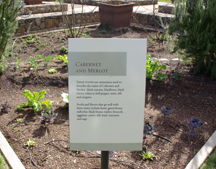 The “Wine in the Gardens” class was a 30-minute class that began in the building. Our guide poured a tasting of Petite Syrah and we headed for the North garden. Here we learned that much of the food grown is used in Julia’s Kitchen. There are demonstration gardens that have plants that pair well with different wines. These are divided into red and white wine gardens. After crossing the highway we entered the South garden. A large section showed the trellising and pruning techniques used for different grape varietals. Our tour ended next to orange trees.
The “Wine in the Gardens” class was a 30-minute class that began in the building. Our guide poured a tasting of Petite Syrah and we headed for the North garden. Here we learned that much of the food grown is used in Julia’s Kitchen. There are demonstration gardens that have plants that pair well with different wines. These are divided into red and white wine gardens. After crossing the highway we entered the South garden. A large section showed the trellising and pruning techniques used for different grape varietals. Our tour ended next to orange trees.
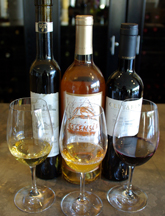 Our next stop was the Wine Spectator flight bar. We decided to try the sweet wine flight. Paired with the wines was a tray of chocolates. The first wine in the flight was a Vidal Ice Wine from Niagara, Canada. It was sweet and paired well with the chocolate. All three wines in this flight were sweeter than the chocolates. The second wine in the flight was an Orange Muscat from California. The wine had orange notes and a hint of foxiness. The third wine was a Monastrell Dulce from Jumilla, Spain. This was a fortified wine high in sugar. An interesting note about the Sweet flight is that wines selected for the flight were from around the world. Other flights available on the day of our visit included Affordable Napa Cabernets, Napa’s Reds, and Judgment of Paris. The wine flights change on a regular basis so one can visit COPIA often and experience different flights.
Our next stop was the Wine Spectator flight bar. We decided to try the sweet wine flight. Paired with the wines was a tray of chocolates. The first wine in the flight was a Vidal Ice Wine from Niagara, Canada. It was sweet and paired well with the chocolate. All three wines in this flight were sweeter than the chocolates. The second wine in the flight was an Orange Muscat from California. The wine had orange notes and a hint of foxiness. The third wine was a Monastrell Dulce from Jumilla, Spain. This was a fortified wine high in sugar. An interesting note about the Sweet flight is that wines selected for the flight were from around the world. Other flights available on the day of our visit included Affordable Napa Cabernets, Napa’s Reds, and Judgment of Paris. The wine flights change on a regular basis so one can visit COPIA often and experience different flights.
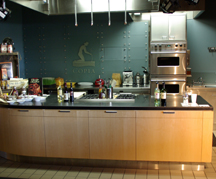 We registered for another class called Introduction to Wine and Food Pairing; held in the Meyer Food Forum. The room is a large semi-circle with several rows of a bar-like table for participants. The kitchen demonstration area is on the lowest level in the front of the room. Our places were already set with two wines, a Sauvignon Blanc and a Cabernet Sauvignon and a plate containing salt, a lemon wedge, rosemary (from the outside garden), dried cherries, chocolate and potato chips. A packet of information and a tasting notes form were at each table setting. Our instructor was very personable and began talking about how some people feel nervous when they are left with the decision to pair wine and food.
We registered for another class called Introduction to Wine and Food Pairing; held in the Meyer Food Forum. The room is a large semi-circle with several rows of a bar-like table for participants. The kitchen demonstration area is on the lowest level in the front of the room. Our places were already set with two wines, a Sauvignon Blanc and a Cabernet Sauvignon and a plate containing salt, a lemon wedge, rosemary (from the outside garden), dried cherries, chocolate and potato chips. A packet of information and a tasting notes form were at each table setting. Our instructor was very personable and began talking about how some people feel nervous when they are left with the decision to pair wine and food.
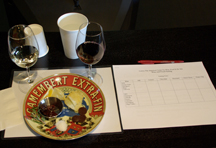 She then led the discussion to the five primary taste sensations present in food: salty, sweet, sour, bitter and umami. We were then instructed to taste the two wines and form opinions of the wines. Next we tasted the salt followed by the white wine, water, more salt and the red wine. Most of the participants thought the salt did not affect the Cabernet Sauvignon, however it cut the acid and softened the Sauvignon Blanc. We then tasted the lemon and followed the previous procedure. Again the participants thought that the lemon did not influence the Cabernet Sauvignon but caused the acid taste to linger with the Sauvignon Blanc. Similar tastings were compared with the remaining food items on our plates. This was a great learning opportunity and afforded the participants the chance to consider the tastes of food when pairing with a wine. Our instructor did emphasize that you should pair what you like. The guidelines mentioned would help when you do not know what wine and food to pair.
She then led the discussion to the five primary taste sensations present in food: salty, sweet, sour, bitter and umami. We were then instructed to taste the two wines and form opinions of the wines. Next we tasted the salt followed by the white wine, water, more salt and the red wine. Most of the participants thought the salt did not affect the Cabernet Sauvignon, however it cut the acid and softened the Sauvignon Blanc. We then tasted the lemon and followed the previous procedure. Again the participants thought that the lemon did not influence the Cabernet Sauvignon but caused the acid taste to linger with the Sauvignon Blanc. Similar tastings were compared with the remaining food items on our plates. This was a great learning opportunity and afforded the participants the chance to consider the tastes of food when pairing with a wine. Our instructor did emphasize that you should pair what you like. The guidelines mentioned would help when you do not know what wine and food to pair.
Our last stop in COPIA was the gift shop Cornucopia. This is a spacious gift shop with books and wine serving equipment. We enjoyed our visit to COPIA and wish we had more time to take more of the class offerings. Future visits will be placed on our itinerary.
COPIA, 500 First Street, Napa, CA 94559
Telephone: 707-259-1600 or 888-51-COPIA (26742)
Website: www.copia.org
